12 Baking Soda Mistakes Everyone Makes
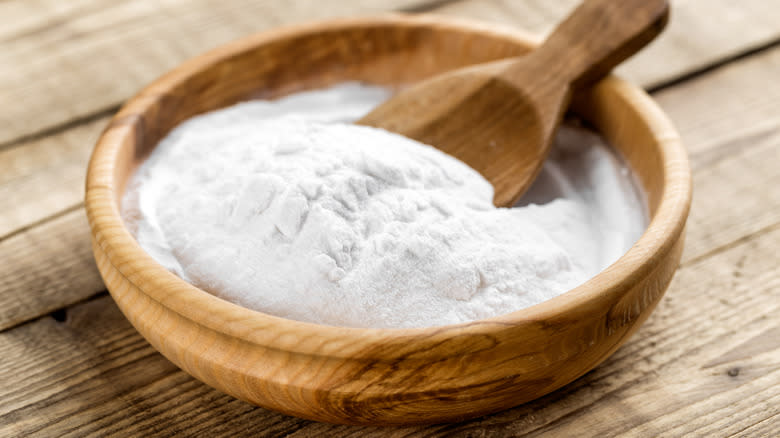
Have you ever found yourself doing a frenzied search for how to get a stain out of your carpet? What about how to get the smell of cat urine out of your couch? Or perhaps you've simply wanted an ingredient that'll help your cake get taller and fluffier? If so, you've surely been met with one of the most popular pieces of advice of the last 200 years: use baking soda. The uses of this handy little powder are seemingly endless. You can use baking soda to cook. You can use baking soda to clean. You can use baking soda to get rid of bad smells or to polish your cutlery or to remove pesticides from your produce. You can even use it to put out small fires, thanks to the carbon dioxide that is emitted when it's heated, which snuffs out the flames.
But even if there are dozens (or hundreds) of things you should do with baking soda, there are also several things that you shouldn't. Baking soda, also known as sodium bicarbonate, is as magical as it seems to be, but only if you use it correctly. Here are a few mistakes you should avoid if you want to get the most out of this kitchen staple.
Read more: The Best Way To Clean That Nasty Grease Off Of Your Kitchen Cabinets
Using Too Much Baking Soda In A Recipe
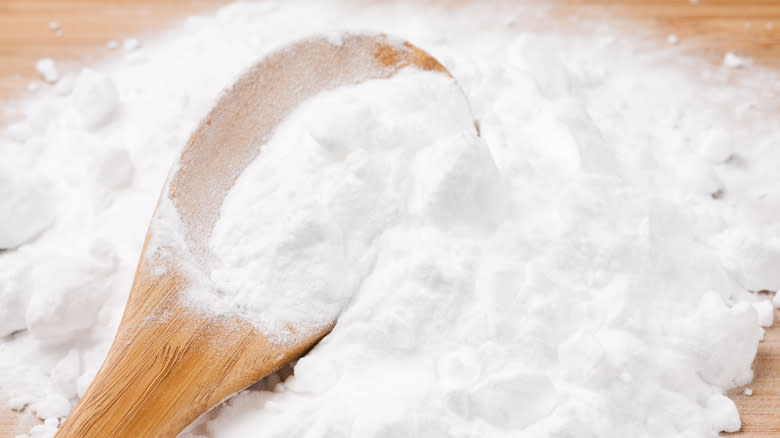
Baking soda is an indispensable part of many recipes. It makes things like cakes, muffins, and pancakes rise -- but only if you use the right amount. While not using enough baking soda will leave you with baked goods that are flat or hard, using too much may be even worse. This flub makes your desserts not only rise unevenly, but also taste terrible. The reason why has to do with science, as do most things in the kitchen.
Baking soda is alkaline, and requires an acid to react. When it comes into contact with something like lemon juice, sour cream, buttermilk, brown sugar, or cocoa powder plus a liquid, it creates bubbles of carbon dioxide. These are what cause the batter of your baked good to rise. However, there are certain rules that must be followed to properly achieve this reaction. If you have the wrong ratio of alkaline to acid, this chemical reaction won't take place, or won't take place properly, leaving you with a wonky-shaped, metallic-tasting mess of a cake. In general, you need around 1/4 teaspoon of baking soda per cup of flour, but always follow your recipe when in doubt.
Not Knowing The Difference Between Baking Soda And Baking Powder
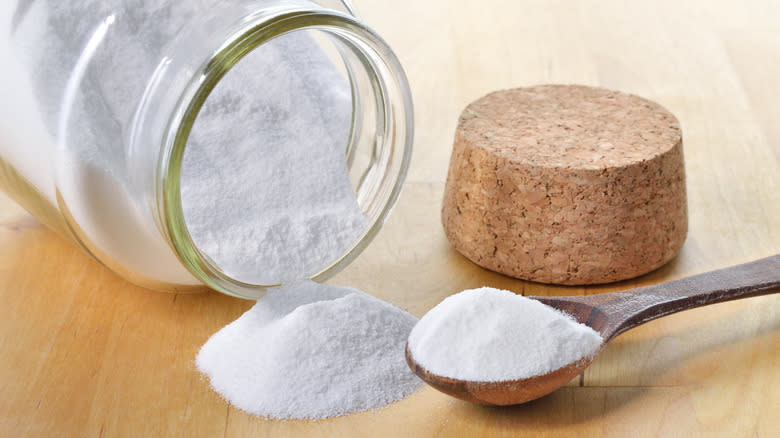
You could be forgiven for thinking that baking soda and baking powder are the same thing -- they do have quite a bit in common. For starters, they look the same, both being white powdery substances. They're also both chemical leaveners that react with other substances to release bubbles of carbon dioxide. However, there is one very important difference between them: acidity.
Baking soda is alkaline and alkaline alone, meaning that it needs an acid and a liquid to react with. Baking powder, on the other hand, is a pre-made mix of baking soda plus an acid like cream of tartar. There is no need to add lemon juice, vinegar, or any other acidic ingredient. There is also the fact that baking soda is three times as strong as baking powder, so you can't do a simple one-to-one swap if you're out of one or the other.
That's not to say that it can't be done at all, though. You can sub in baking soda for baking powder by reducing the amount and adding an acid. As a basic rule, you should use 1 teaspoon of lemon juice or vinegar for 1/2 teaspoon of baking soda. Also remember that every teaspoon of baking powder needed for the recipe will become 1/3 teaspoon for this substitution. If you prefer, you can also simply create your own baking powder using one part baking soda and two parts cream of tartar.
Not Testing If Your Baking Soda Is Active
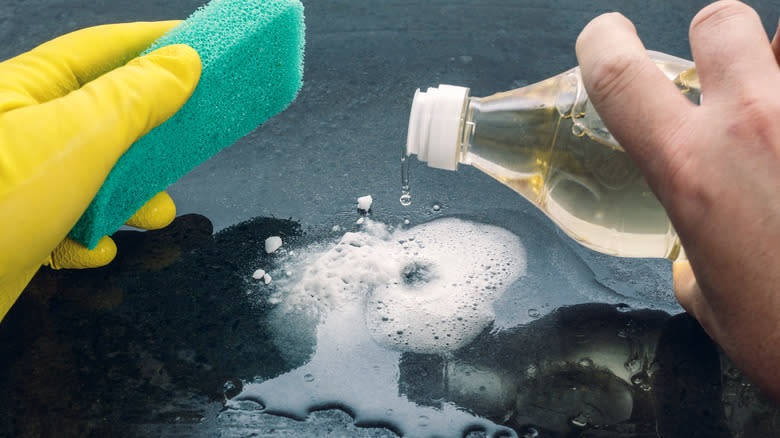
As wonderful as baking soda is, it's not immortal. Over time, baking soda loses its efficacy, meaning that it won't work like it should to make your cakes and waffles rise. Since it's impossible to tell just by looking whether it's still active or not, you should know how to do a simple test. First, get a small bowl or cup and place three tablespoons of vinegar inside. Add in a teaspoon of baking soda and stir. Did it fizz? If so, your baking soda is still active and good to use for baking. If it had no reaction or just a tiny one, it will no longer work for this purpose.
But don't throw away that box of baking soda just yet -- even inactive baking soda can still be useful around the house. If you place it in your refrigerator or other areas where there's a lot of odor or moisture buildup, it can absorb bad smells and keep things fresh.
Leaving It On Meat For Too Long
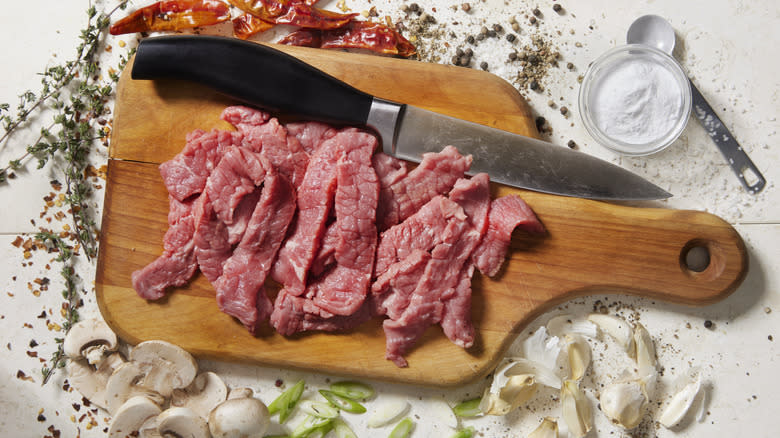
You might already be nodding in recognition at the notion of using baking soda to take meat to a new level. But you might also be confused. Admittedly, it does sound a bit strange. This is a method called velveting, and it involves using either baking soda or a mixture of egg whites, oil, and cornstarch to tenderize your meat. The process is simple: Just cut your raw meat into chunks and toss it with 3/4 teaspoon of baking soda. Then, let it sit for 15 minutes before rinsing and patting dry. Some websites also recommend brining your meat in a baking soda and water solution and letting it sit in the fridge for several hours.
But using baking soda in this way can be tricky. For one thing, America's Test Kitchen reports that leaving your meat in contact with baking soda for longer than 15 minutes has no increased effect on its tenderness. It can also change its flavor in a bad way. Leaving your meat in a mixture of water and baking soda for too long will make it taste metallic, sweet, or soapy, which is not what you want out of a steak. Velveting is a worthwhile technique, but use it with caution.
Using Baking Soda When You Should Use Vinegar
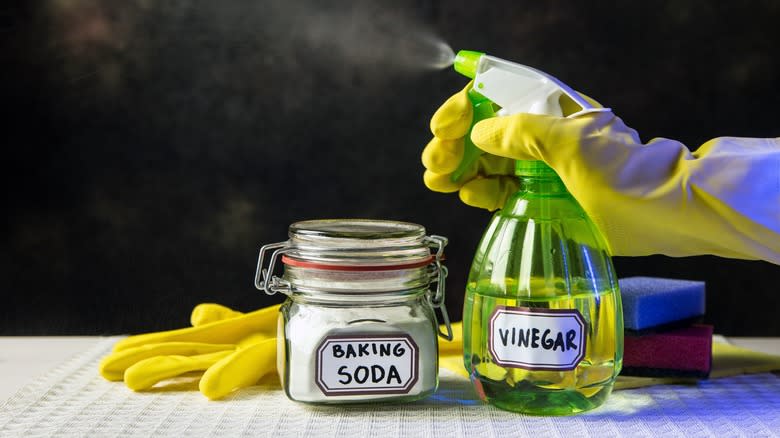
Baking soda is a terrific ingredient in homemade household cleaners because it's abrasive enough to break up stuck-on dirt, but gentle enough to use on many surfaces. In fact, it's so effective that it was once used to clean the Statue of Liberty so as not to scratch its paint. But this magic cleaner shouldn't actually be used on everything.
Glass, for example, can be scratched by baking soda's small, hard particles. While your glass cooktop or countertop should most likely be safe, thinner glass items like cups or plates can be ruined if they are cleaned with baking soda. Ceramic is also prone to scratching, so it's not a good idea to get out the sponge and go to work on your ceramic stove or ceramic dishes with a thick baking soda paste the next time they get dirty. In the case of both of these materials, vinegar is a better option if you're looking for a gentle, natural cleaner.
Not Using It To Make Hummus
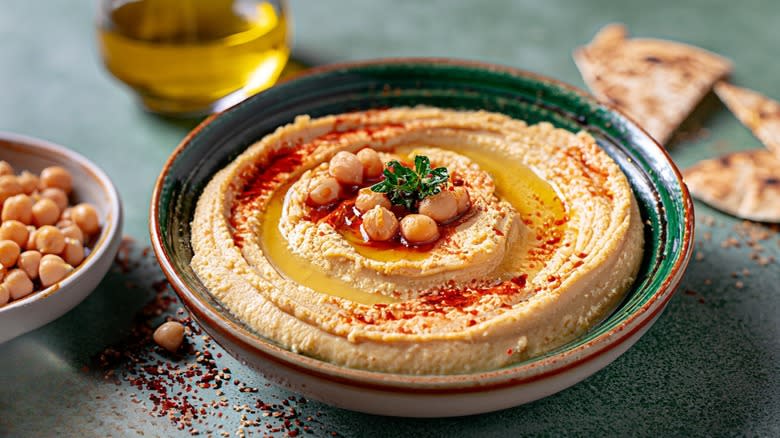
If you're a fan of homemade hummus but not a fan of the gas and bloating that can come with it, you're going to want to reach for your box of baking soda right now. Letting your chickpeas soak in a mixture of water and baking soda overnight leads to a chemical reaction that softens the chickpeas far better than just plain water can. The baking soda raises the pH level of the liquid, tenderizing the chickpeas. This can cut down on indigestion in a major way.
But wait, that's not all! Chickpeas and other legumes are well-known for their negative (read: gassy) effects on the stomach, but baking soda lowers the amount of oligosaccharides in these golden morsels. Normally, oligosaccharides wreak havoc on the digestive system because they are not easily broken down by our bodies. The baking soda helps to get that process started, however, so you can eat your hummus without worrying about the bloaty side-effects.
Leaving Baking Soda In Your Aluminum Pans
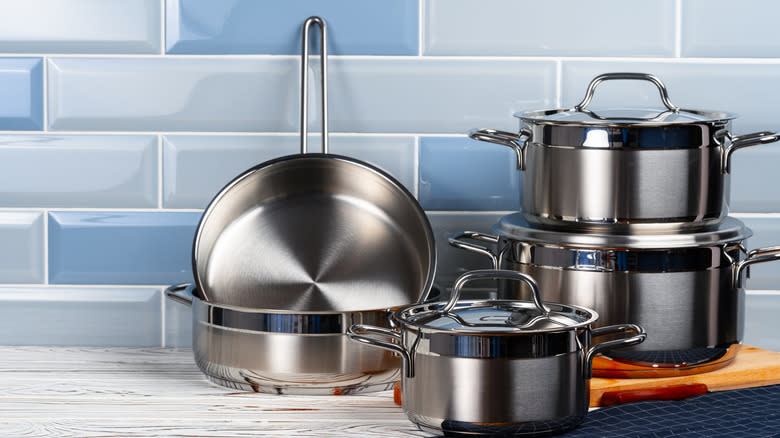
As you already know, baking soda is usually a great cleaner, but there are a couple surfaces that are better off without it. Aluminum, for example, is something that should never be cleaned with baking soda, or at least not for an extended period of time. Unlike with some types of glass, aluminum most likely won't get scratched by baking soda -- but it will react to it. Baking soda is a chemical, and when it comes into contact with an alkali like aluminum for more than just a brief moment, it causes a change to take place. Oxidation occurs on the surface of the metal, making it change colors.
So, if you want to use baking soda to clean stubborn, stuck-on food from an aluminum pot or pan, make sure to do so quickly and rinse it extremely well. Leaving the pan to soak with baking soda inside will ruin it. If you're at all wary about your ability to follow these rules, it's probably better to stick with other cleaners for this sort of cookware.
Using It To Caramelize Onions
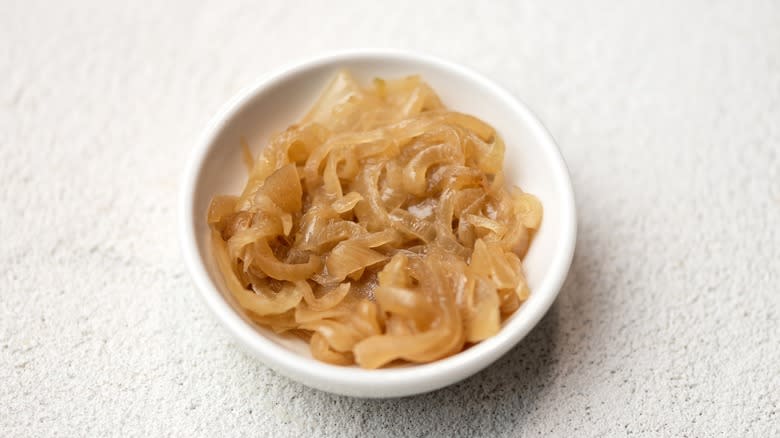
If you do a search on the internet for cooking hacks involving baking soda, you will no doubt find a site (or 10) that recommend using baking soda to caramelize your onions. Do not follow this advice. While it's true that baking soda does speed up the caramelization process and make your onions get brown faster, they will taste just plain awful. Onions made this way will have a bitterness reminiscent of chemicals, because that's what baking soda is. It's sure to ruin your burger or sandwich.
The alkaline properties of baking soda also weaken the pectin in the cells of the onion slices, which helps them to get softer quicker -- but they work a bit too well. No matter how much or how little baking soda you add, your onions will end up an oddly colored, mushy pile that looks as off-putting as it tastes. Even though it takes longer, it's better to caramelize your onions the old-fashioned way, without any chemical assistance.
Not Storing Your Baking Soda Correctly
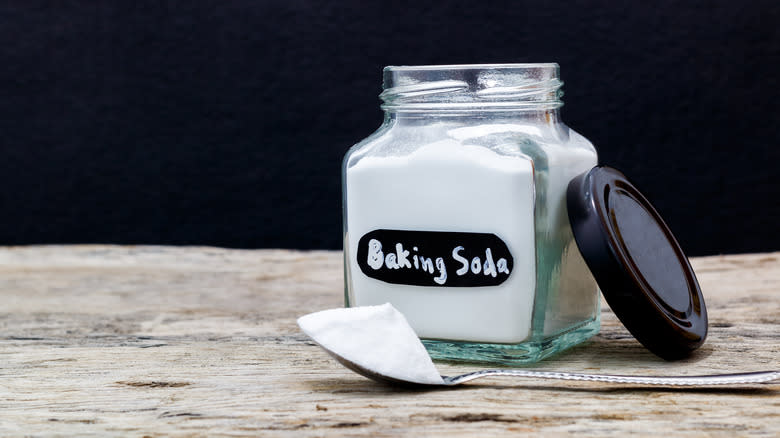
Most people open a box of baking soda, use a bit, then shove the box into the cabinet or pantry and forget about it. It doesn't spoil like food does, so what does it matter if it isn't air-tight? Well, it actually matters a lot if you want to keep your baking soda fresh and active.
Baking soda often comes in a cardboard box, but, believe it or not, this is not the best storage container for it. This cardboard box can't be resealed, meaning that the baking soda inside will still be able to absorb odors and moisture from its surroundings. This may mean a less smelly cabinet, but it also means that you won't be able to use the baking soda for as long.
The best way to store baking soda is in a clean, dry jar; a spice jar with a lid with holes in it so that you can close it tightly and shake it out at will is especially ideal. Vacuum sealing is also an option, especially if you buy your baking soda in large quantities that you hope will last a long time. Whichever storage method you choose, it should be kept in a dark, cool place away from any dampness. You should also keep it away from strong-smelling foods or cleaning products, because it can take on their scent.
Using The Same Baking Soda For Deodorizing And Cooking
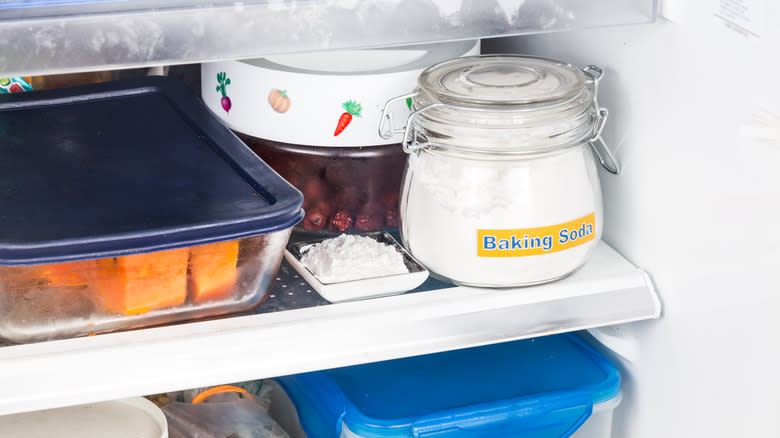
Baking soda can be used in cooking and it can be used to absorb odors in your refrigerator. But you shouldn't use the same container of baking soda to do both of these things. Let's put it this way: Would you want to bake a cake with the scent of old onions in it? How about smelly raw fish? Past-its-prime milk? Probably not.
"When we utilize baking soda as an odor reducer, the molecules in the air react to the baking soda to grasp those odors," Trisha Lake of TLC Cleaning told Martha Stewart. In other words, baking soda neutralizes smells by drawing the smell into itself. If you were then to use that baking soda in a recipe, you would be adding the smell it absorbed to whatever you're making. This is why it is always best to have two boxes of baking soda: one for cooking and one for deodorizing.
Not Using It To Clean Your Drain
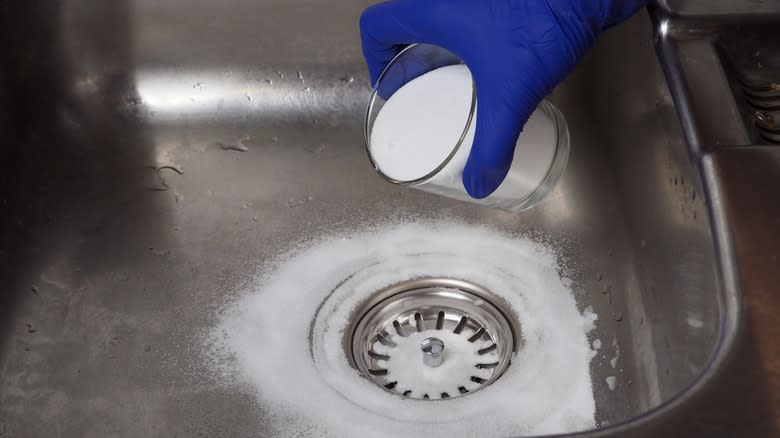
Kitchen and bathroom sinks are both notorious for clogging. It can be a real pain to set aside time to unclog them or, if worse comes to worse, call a plumber. But baking soda can help you keep things from getting that far.
For one thing, you can regularly sprinkle a bit of baking soda in the sink and wash it down the drain with some hot water to keep clogs from building up in the first place. If you already have a slow sink or a small clog, though, you can still rely on baking soda for help. First, dump a pot of boiling water down the drain. Then, put 1/2 cup of baking soda in the drain and leave it there for around five minutes. Once time is up, quickly dump one cup of vinegar and one cup of boiling water onto the baking soda, which will start a reaction. Plug the sink with the stopper to keep the fizzing confined to the pipe (although this is not necessary), then finish up with one more pot of boiling water. Voila, you've got a smoothly draining sink again.
Cleaning Marble Countertops With Baking Soda
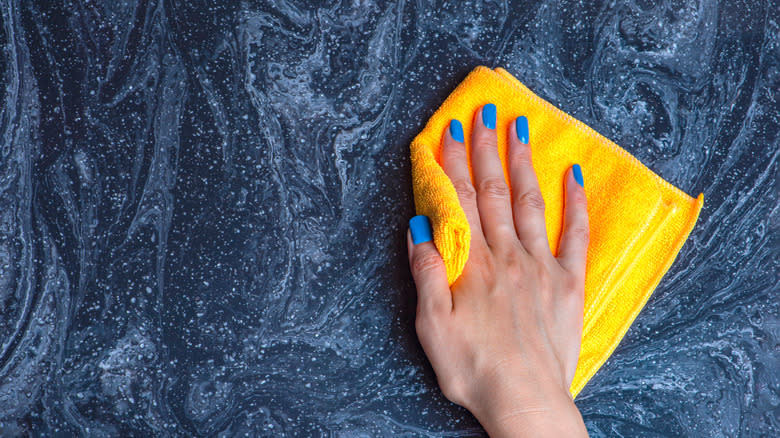
If you have a marble or quartz countertop, you know that these surfaces are quite beautiful. But they're also pricey and, let's be honest, quite finicky. You should only use certain cleaners to remove messes from your marble countertop, and baking soda is not one of them. The abrasive material can scratch and break down the sealant on the surface and eventually the stone beneath, which will make it lose its luster and sleek appearance.
A better way to clean this type of surface is with an average and gentle soap and water mixture. Dish soap works perfectly, but make sure that it's pH neutral. Use a soft microfiber cloth instead of a scratchy sponge as well, otherwise you run the same risk of ruining the surface layer. Be sure to wipe down the counter thoroughly to remove all traces of soap and keep it in good, shiny shape.
Read the original article on Daily Meal.